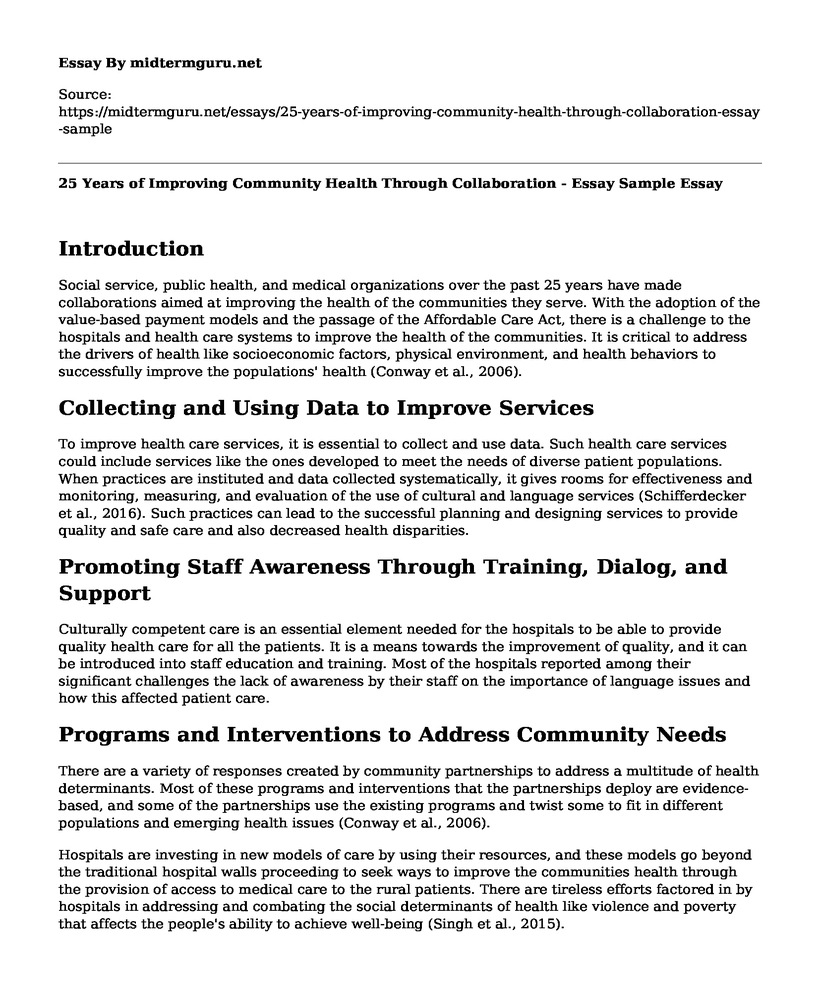Introduction
Social service, public health, and medical organizations over the past 25 years have made collaborations aimed at improving the health of the communities they serve. With the adoption of the value-based payment models and the passage of the Affordable Care Act, there is a challenge to the hospitals and health care systems to improve the health of the communities. It is critical to address the drivers of health like socioeconomic factors, physical environment, and health behaviors to successfully improve the populations' health (Conway et al., 2006).
Collecting and Using Data to Improve Services
To improve health care services, it is essential to collect and use data. Such health care services could include services like the ones developed to meet the needs of diverse patient populations. When practices are instituted and data collected systematically, it gives rooms for effectiveness and monitoring, measuring, and evaluation of the use of cultural and language services (Schifferdecker et al., 2016). Such practices can lead to the successful planning and designing services to provide quality and safe care and also decreased health disparities.
Promoting Staff Awareness Through Training, Dialog, and Support
Culturally competent care is an essential element needed for the hospitals to be able to provide quality health care for all the patients. It is a means towards the improvement of quality, and it can be introduced into staff education and training. Most of the hospitals reported among their significant challenges the lack of awareness by their staff on the importance of language issues and how this affected patient care.
Programs and Interventions to Address Community Needs
There are a variety of responses created by community partnerships to address a multitude of health determinants. Most of these programs and interventions that the partnerships deploy are evidence-based, and some of the partnerships use the existing programs and twist some to fit in different populations and emerging health issues (Conway et al., 2006).
Hospitals are investing in new models of care by using their resources, and these models go beyond the traditional hospital walls proceeding to seek ways to improve the communities health through the provision of access to medical care to the rural patients. There are tireless efforts factored in by hospitals in addressing and combating the social determinants of health like violence and poverty that affects the people's ability to achieve well-being (Singh et al., 2015).
Developing Partnerships
Ideally, health systems and hospitals are to improve the health of their communities. These institutions do not only have the expertise of improving health, but most of the hospitals are also one of the largest employers in their communities, and through this, they have managed to establish strong reputations as significant stakeholders in such communities. Improving the health of communities is a multifaceted approach that a single organization cannot achieve. There can be an impact by each organization working independently, but the effect can become much higher if these organizations partner with each other towards a shared goal (Schifferdecker et al., 2016). To build a culture of health, it is essential to have this collaborative approach; it creates a society where there is an equal opportunity for every individual to live the healthiest life possible, regardless of their race, ethnicity, physical appearance, geographic location, or socioeconomic status.
To build a culture of health, it is critical to developing partnerships to address the health needs of the community. For years now, regardless of the traction that the necessity for collaborative action has gained in the health care field, most of the health care systems and hospitals have still been working with the communities. An effective way to strengthen partnership is to leverage existing assets in the community. A development plan based on the asset has its primary focus on the identification of available resources within the community and then establish stronger relationships between all the community organizations.
References
Conway, J., Johnson, B., Edgman-Levitan, S., Schlucter, J., Ford, D., Sodomka, P., & Simmons, L. (2006). Partnering with patients and families to design a patient-and family-centered health care system: a roadmap for the future: a work in progress. Bethesda, MD: Institute for Family-Centered Care. chrome-extension://oemmndcbldboiebfnladdacbdfmadadm/http://www.hpoe.org/Reports-HPOE/2016/creating-effective-hospital-community-partnerships.pdf
Schifferdecker, K. E., Bazos, D. A., Sutherland, K. A., LaFave, L. R. A., Fedrizzi, R., & Hoebeke, J. (2016). A review of tools to assist hospitals in meeting community health assessment and implementation strategy requirements. Journal of healthcare management/American College of Healthcare Executives, 61(1), 44. https://www.ncbi.nlm.nih.gov/pmc/articles/PMC4830260/
Singh, S. R., Young, G. J., Daniel Lee, S. Y., Song, P. H., & Alexander, J. A. (2015). Analysis of hospital community benefit expenditures' alignment with community health needs: evidence from a national investigation of tax-exempt hospitals. American journal of public health, 105(5), 914-921. https://scholar.google.com/scholar_url?url=https://ajph.aphapublications.org/doi/abs/10.2105/AJPH.2014.302436&hl=en&sa=T&oi=gsb&ct=res&cd=0&d=11858685945296274190&ei=uabUXKDZHZC4mgH297SAAQ&scisig=AAGBfm2_O-NFMA2QVVEHPcXz_YFnORef0w
Cite this page
25 Years of Improving Community Health Through Collaboration - Essay Sample. (2023, Jan 11). Retrieved from https://midtermguru.com/essays/25-years-of-improving-community-health-through-collaboration-essay-sample
If you are the original author of this essay and no longer wish to have it published on the midtermguru.com website, please click below to request its removal:
- Discussion on the Influence of Facebook on the Subjective Well-Being of the Users With Respect to Behavioral Adaptations
- Art Essay Sample: Migrant Mother - Photograph by Dorothea Lange
- The Debate Over the Approval of New Opioid Drug
- Overtime in Nursing Leads To Adverse Patient Outcomes: Research Paper
- Preventive Medicine: Primary, Secondary and Tertiary Prevention - Essay Sample
- Operant Conditioning: How It Can Shape Human Behavior - Essay Sample
- Depression: A Severe Medical Illness With Treatments Available - Essay Sample







